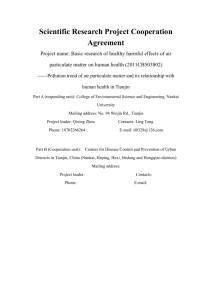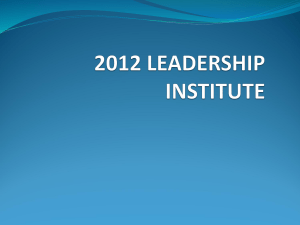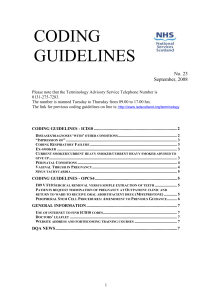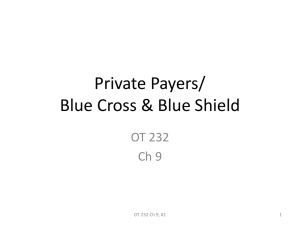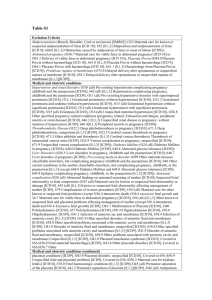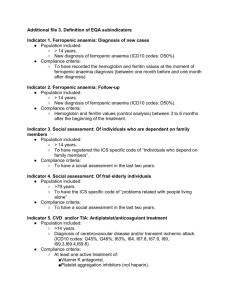Revenue & Reimbursement - is on www.oregonhfma.org.
advertisement
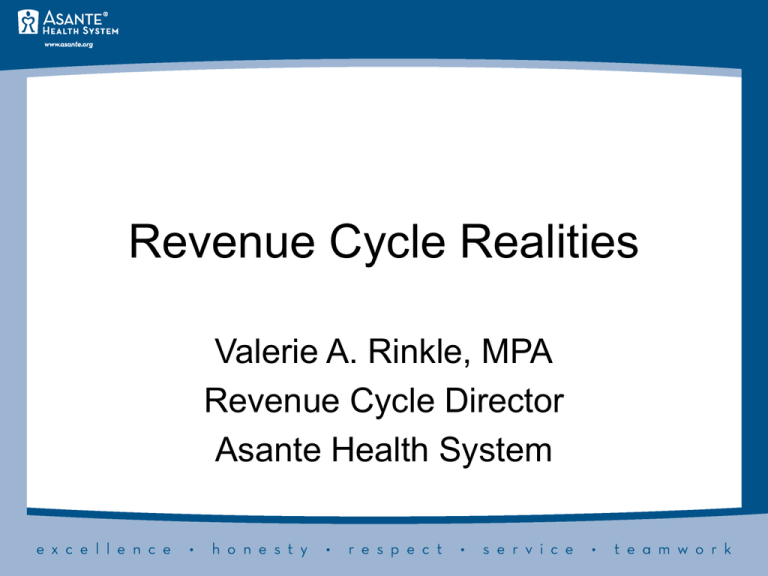
Revenue Cycle Realities Valerie A. Rinkle, MPA Revenue Cycle Director Asante Health System The Financial Equation • Revenue minus expense = bottom line • Improved bottom line comes from either increasing revenue, decreasing expense or both!! • Revenue Cycle Managers just like Clinical Managers must be successful at both! Today’s Agenda • Review phases & functions of Revenue Cycle Operations • Discuss management issues for Revenue Cycle • Discuss operational challenges & people/process/technology solutions for some of those challenges • Discuss strategies for collaborating with clinical & non-clinical departments crucial for Revenue Cycle success • Future Issues Raising Challenges Major Phases of Revenue Cycle • • • • Pre-Service Service Delivery Account Suspense Period Billing & Collections – Each phase consists of several functions performed sequentially and/or concurrently Management of Revenue Cycle • Overarching all phases & functions of the revenue cycle is the management of people, processes & technology • Improvement analytics should dictate prioritization • Regardless of organizational structure, collaboration with other departments is crucial for revenue cycle success Management of Revenue Cycle (cont.) • For each function of revenue cycle – think about: – Quality improvement/cost reduction/automation & informatic initiatives & strategies – Compliance & documentation requirements – Employee success initiatives – Patient satisfaction initiatives – Alignment with Organization’s strategic plan – Outcome measures with targets and results – Barriers & key stakeholders – Who is the leader for this area Pre-Service Phase Functions • • • • • • • Scheduling Eligibility Verification Pre-Admission Financial Counseling/Healthcare Eligibility Coverage, Authorizations & Waivers Point-of-Service Collections Compliance & Documentation of all functions Scheduling • • • • • Centralized Scheduling? De-centralized Scheduling? Feedback loop for missing information? Relationship to authorizations? Late Add-On Accounts? Verification • Eligibility Verification – Real time? – 270/271 batch? – Manual web site reseach – Web-bot technology? – CMS instability/OR MMIS inaccuracy Pre-Admission • Creating accounts versus calling patients- work list differentiation • Swing shift schedules for optimal patient contact • Scripting to support patient satisfaction initiatives • Late add-on analysis Financial Counseling/Healthcare Eligibility Assessments • Financial Assistance Policy – Up-Front Charity determination • Financial Assistance for elective procedures? • True Self Pay contractual at average commercial rates or Medicare rates • Terms for interest-free payment plans • Loans for long-term payment plans • Publicizing Financial Assistance • Expert Governmental Healthcare Eligibility Assistance Coverage Verification/Authorization & Waivers • Authorizations – Notification of admission versus authorization for O/P service • Professional versus facility authorization • Imaging authorizations • Referring Office Issues • 2010 OIG Advisory Opinions • Registration staff versus RNs? • Reference labs – missing info on orders • ABNs for O/P Services • OHP ED Waivers for non-emergent use of ED Point-of-Service Collections • Cost Estimates – how services are scheduled vs how they are billed? • Incentives for up-front payment? • Prompt-pay discounts? • Phone collections during Pre-Admission? • ED collections • Inpatient Admissions • Incentives for staff to collect Compliance & Documentation Requirements • Condition of Services Rendered, HIPAA, Patient Rights, Genetic Research OptOut,Red Flag • Financial Assistance & Cost-estimate • IMM/ABN/Waivers • Off-campus PBD cost estimates • eSignature – direct to EMR vs paper & scan • Audit software to edit/audit all accounts • Productivity standards Timing is Everything! • A lot of work happens between the service being scheduled and the actual date of service – how much time is optimal? • More & more requirements at time of Patient Check-in- How much time needed to keep Clinical on-time? Service Delivery Phase • Activate the account – correct inpatient admission date/time • Admission status • Documentation of services – orders & execution of orders • Charge capture – dep't info systems, EMR vs key punch & development from documentation Suspense Phase • Begins at Discharge – ends when bill drops • Charge capture reconciliation • Charge capture audits w/o coding • Coding – automated work lists, telecommunting, cross-training, ICD10 • Coding & charge capture edits w/coding Billing & Collections • • • • • • • • • • Day end automation CDM & profile maintenance in AR system Informatics 3-day rule, readmissions (Medicare vs Medicaid) Adverse Event auditing Claim scrubbing/clearinghouse Account segmentation for AR follow-up Payment validation ERA/Lockbox On-line patient payments & discounts Billing & Collections (cont.) • • • • Late Charge Management Denial Management Financial Assistance Approvals Account segmentation for collections – inhouse vs outsourcing • Batch 270/271 eligibility • Collection cycle – scripting, prompt-pay discounts & dunning messages/timing • Collection practices – agencies, liens, etc. Important Definitions FYI • Never Events – 3 types of Adverse Events that are NEVER covered by insurance: – 1-Procedure performed on the wrong body part – 2-Procedure performed on the wrong patient, or – 3-The wrong procedure performed on the patient Important Definitions FYI • Adverse Events – OAHHS defined a list including such things as foreign body retention after procedure, blood incompatibility, burn caused by facility • Commercial plans & their lists - Contracts • Hospital-Acquired Conditions – Defined by CMS based on coding of conditions not Present on Admission (POA) such as stage 3 or 4 pressure ulcers, UTI from indwelling catheters. Denial Management • Tracking RAC requests • Collaborating with Release of Information • Chart analysis prior to sending to RAC • Response letter and appeal tracking • Results reporting to Management RAC Experience • Automated & Complex Accounts – – – – Under 100 accounts? 100-500 accounts? 500-1000 accounts? Over 1000 accounts? • Appeals for Automated & Complex Accounts? • Complex for DRG, Medical Necessity, Other? • Part B RACs – supplies, coding, other? Strategies for Collaboration • Revenue Dept Mgr Education on Denials Government payers and increasingly commercial insurances are mounting massive initiatives to take away payments we have already received. We have to get better at documentation and following complex rules to hold onto our payments from Medicare, Medicaid & Commercial payers. Health reform increases these initiatives!! Strategies for Collaboration (cont.) • Explain Revenue Cycle’s relationship to the Value Equation • Value Equation: Quality/Cost – – – – Reduced readmissions Reduced Hospital-Acquired Conditions Reduced adverse/serious safety events Improved compliance with I/P & O/P CMS Core Measures – Improved patient satisfaction Strategies for Collaboration (cont.) • Explain Revenue Cycle’s Role in Improving Customer Service • Customer Service – Patients increasingly expecting up-front estimates – ADT linking to EMR – safety in correct patient ID paramount! – Performing your organizations values consistently with each interaction throughout the Revenue Cycle – Patient relations & Risk Management Strategies for Collaboration (cont.) • Educate PI, Risk Mgt & Revenue Dept Mgrs on Documentation Needs based on Denial Analysis • Clinical staff should “Always Consider” – Can I, as a provider of service tell the story of my patient care from the resulting documentation [i.e., the legal medical record] one or more years after the service? Strategies for Collaboration (cont.) • Clinical Documentation Improvement Program – Coding & CDIS staff collaboration critical – Review of RAC denials – Adjusted mortality • Since only physicians and other practitioners can diagnose & perform certain procedures by virtue of their scope of practice, then only their authenticated documentation can be used to substantiate coding Strategies for Collaboration (cont.) • Is your IT department maxed-out with meaningful use projects? • Consider a Revenue Cycle IT dept • Is Revenue Cycle present at CPOE & EMR planning sessions? Charge capture automation possible with EMR integration. Future Issues & Challenges • ICD10 • Increased regulations of outpatient services • Payment Reform • Cost Reform ICD10 ICD9 Diagnosis Codes Used by hospitals, physicians & payers. Dependent on practitioner documentation Approximately 14,000 codes Alpha-numeric 2-5 characters Few codes available for expansion Lacks detail w/non-specific codes ICD9 Procedure Codes Used by hospitals & payers for Inpatients Dependent on practitioner documentation Approximately 3,000 codes Based on outdated terminology Few codes available for expansion Lacks detail w/o method or approach for procedures or body part definitions Limits DRG assignment ICD10 Diagnosis Codes Used by hospitals, physicians & payers. Dependent on practitioner documentation Approximately 68,000 codes Alpha-numeric 4-7 characters Codes available for expansion Very specific for improved reporting of morbidity ICD10 Procedure Codes Used by hospitals & payers for Inpatients Dependent on practitioner documentation Approximately 87,000 available codes Reflects current terminology & devices Codes available for expansion Precisely defines procedures w/detail on body part, approach, method & devices used. Allows improived DRG definitions for new technology and devices Outpatient Services • Two types of outpatient services: – Diagnostic – think tests – Therapeutic including ED visits & RN services – think assessment/tx • CMS supervision rules • Orders for services – electronic vs paper vs oral • Provider-based – how much longer? Payment Reform • Financial systems & allocation strategies – RBRVS, fee schedules, Medicare rates, aligning incentives • Bundled payments • Accountable Care Organizations • Oregon – exchange estimated 34% of population on State exchange insurance Cost Reform • Bending the cost curve – Automation & Informatics – Performance standards – Telecommuting – Presumptive charity – Aligning incentives Questions? Thank you!!


